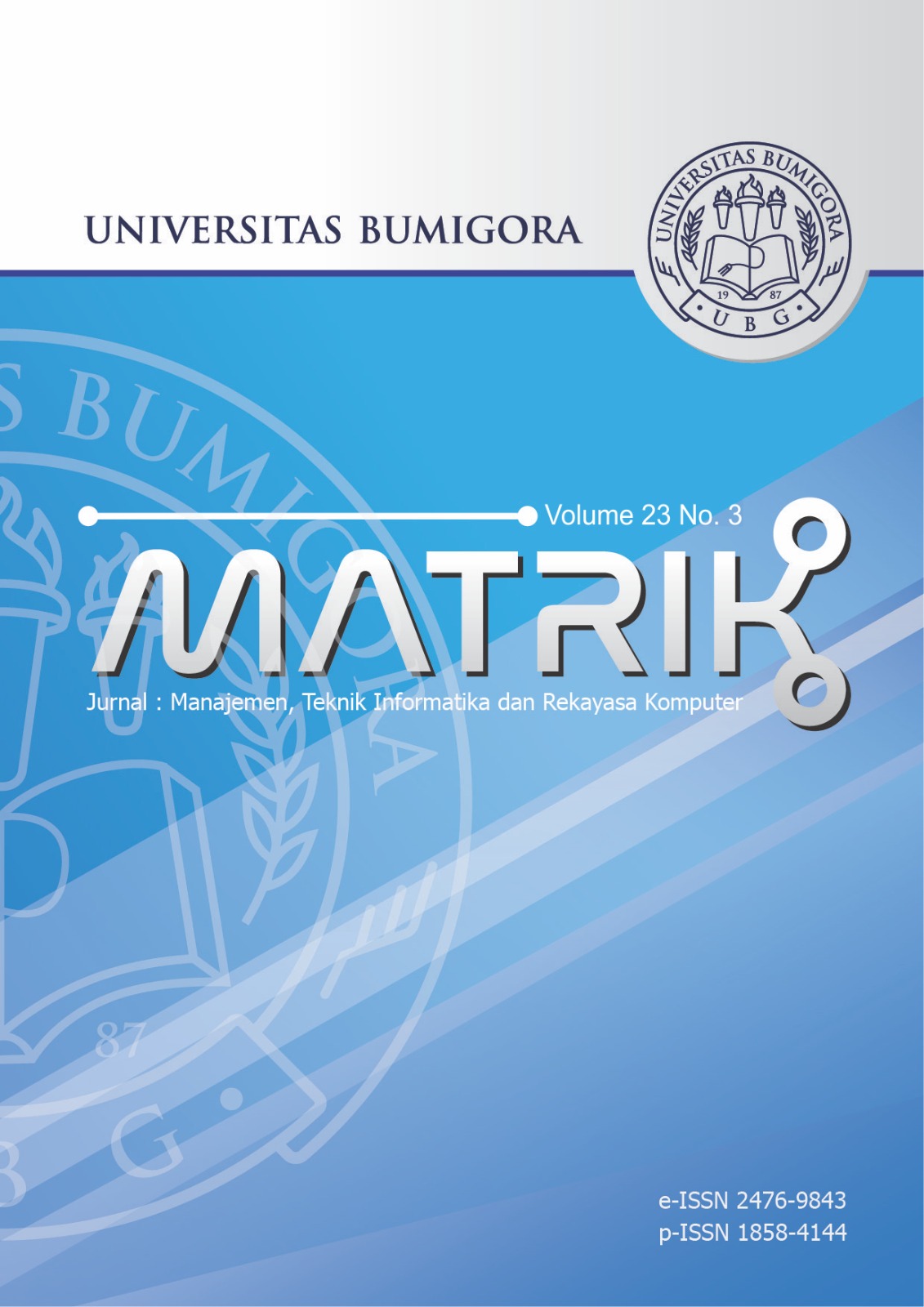Development of the Multi-Channel Clustering Hierarchy Method for Increasing Performance in Wireless Sensor Network
DOI:
https://doi.org/10.30812/matrik.v23i3.3348Keywords:
Clustering Hierarchy, Multi-Channel, Performance, Sensor Network, Wireless Sensor NetworkAbstract
Wireless Sensor Networks are technologies that make it possible to observe phenomena. The problem is data delays in covering the distance from the origin to the destination. Packet Loss is a condition that shows the number of lost packets and the total queue length caused by data processing time. This research aims to develop a cluster-based protocol. This research uses a multichannel hierarchical clustering method and adds odd-even by dividing the network into several channels and forming a cluster head for each channel. The results of this research are Channel 1 with a throughput value of 1.88, channel 2 with a throughput value of 21.68, channel 3 with a throughput value of 1.62, and channel 4 with a throughput value of 42.44. The conclusion of this study is that the throughput results are smaller compared to the Multi-Channel Clustering H ierarchy method, because not all nodes are active
Downloads
References
sensor networks,†Measurement, vol. 230, no. 5, pp. 1144–1154, 2024, https://doi.org/10.1016/j.measurement.2024.114478.
[2] B. Saemi and F. Goodarzian, “Energy-efficient routing protocol for underwater wireless sensor networks using a hybrid
metaheuristic algorithm,†Engineering Applications of Artificial Intelligence, vol. 133, no. 7, pp. 1081–1091, 2024, https:
//doi.org/10.1016/j.engappai.2024.108132.
[3] A. O. Khadidos, N. Alhebaishi, A. O. Khadidos, M. Altwijri, A. G. Fayoumi, and M. Ragab, https://doi.org/10.1016/j.aej.2024.
02.064.
[4] S. El Khediri, A. Selmi, R. U. Khan, T. Moulahi, and P. Lorenz, “Energy efficient cluster routing protocol for wireless
sensor networks using hybrid metaheuristic approaches,†Ad Hoc Networks, vol. 158, no. 5, p. 103473, 2024, https:
//doi.org/10.1016/j.adhoc.2024.103473. [Online]. Available: https://linkinghub.elsevier.com/retrieve/pii/S1570870524000842
[5] M. Sudha, D. Chandrakala, S. Sreethar, and A. Shrivindhya, “Energy efficient spiking deep residual network and binary horse
herd optimization espoused clustering protocol for wireless sensor networks,†Applied Soft Computing, vol. 157, no. 5, pp.
1114–1121, 2024, https://doi.org/10.1016/j.asoc.2024.111456.
[6] W. Liu, G. Wei, and M. Zhu, “A survey on multi-dimensional path planning method for mobile anchor node localization
in wireless sensor networks,†Ad Hoc Networks, vol. 156, no. 4, pp. 1342–1352, 2024, https://doi.org/10.1016/j.adhoc.2024.
103416.
[7] C. Jiang, W. Chen, J. Wang, Z. Wang, and W. Xiao, “An improved deep q-network approach for charging sequence scheduling
with optimal mobile charging cost and charging efficiency in wireless rechargeable sensor networks,†Ad Hoc Networks, vol.
157, no. 4, pp. 1033–1043, 2024, https://doi.org/10.1016/j.adhoc.2024.103458.
[8] H. Azarhava, M. P. Abdollahi, J. M. Niya, and M. A. Tinati, “Joint resource allocation and uav placement in uav-assisted
wireless powered sensor networks using tdma and noma,†Ad Hoc Networks, vol. 157, pp. 1034–1044, 4 2024, https://doi.org/
10.1016/j.adhoc.2024.103459.
[9] Y. Song, S. Zhang, and S. Wang, “An energy efficient fusing data gathering protocol in wireless sensor networks,†Computer
Networks, vol. 243, no. 4, pp. 1103–1113, 2024, https://doi.org/10.1016/j.comnet.2024.110305.
[10] P. Tripathy and P. Khilar, “Pso based amorphous algorithm to reduce localization error in wireless sensor network,†Pervasive
and Mobile Computing, vol. 100, no. 5, p. 10181028, 2024, https://doi.org/10.1016/j.pmcj.2024.101890.
[11] K. R. S. Kumar and S. Gopikrishnan, “Caddisfalcon optimization algorithm for on-demand energy transfer in wireless rechargeable
sensors based iot networks,†Sustainable Energy Technologies and Assessments, vol. 64, no. 4, pp. 1037–1047, 2024,
https://doi.org/10.1016/j.seta.2024.103732.
[12] A. Hag, D. Handayani, T. Pillai, T. Mantoro, M. H. Kit, and F. Al-Shargie, “Eeg mental stress assessment using hybrid multidomain
feature sets of functional connectivity network and time-frequency features,†Sensors, vol. 21, no. 9, pp. 6300–63 010,
2021, https://doi.org/10.3390/s21186300.
[13] B. A. Lungisani, A. M. Zungeru, C. Lebekwe, and A. Yahya, “Autoencoder-based image compression for wireless sensor
networks,†Scientific African, vol. 24, no. 6, pp. 1894–1904, 2024, https://doi.org/10.1016/j.sciaf.2024.e02159.
[14] M. Shanmathi, A. Sonker, Z. Hussain, M. Ashraf, M. Singh, and M. Syamala, “Enhancing wireless sensor network security and
efficiency with cnn-fl and ngo optimization,†Measurement: Sensors, vol. 32, no. 4, pp. 1010–1022, 2024, https://doi.org/10.
1016/j.measen.2024.101057.
[15] R. Rizky, Mustafid, and T. Mantoro, “Improved performance on wireless sensors network using multi-channel clustering hierarchy,â€
Journal of Sensor and Actuator Networks, vol. 11, no. 1, pp. 73–84, 2022, https://doi.org/10.3390/jsan11040073.
[16] S. S. Babu and N. Geethanjali, “Lifetime improvement of wireless sensor networks by employing trust index optimized cluster
head routing (tiochr),†Measurement: Sensors, vol. 32, no. 4, pp. 1010–1020, 2024, https://doi.org/10.1016/j.measen.2024.
101068.
[17] S. Jaiswal and M. S. Ballal, “Fuzzy inference based irrigation controller for agricultural demand side management,†Computers
and Electronics in Agriculture, vol. 175, no. 8, pp. 1055–1065, 2020, https://doi.org/10.1016/j.compag.2020.105537.
[18] J.-Y. Lee, B. Lim, and Y.-C. Ko, “Performance analysis of multi-hop low earth orbit satellite network over mixed rf/fso links,â€
ICT Express, vol. 110, no. 3, 2024, https://doi.org/10.1016/j.icte.2024.03.004.
[19] C. R. K. J, R. D. Kulkarni, and D. M. Majid, “Energy-efficient architecture for high-performance fir adaptive filter using
hybridizing csdtcse-crabra based distributed arithmetic design: Noise removal application in iot-based wsn,†Integration, vol. 97,
no. 7, pp. 167 – 260, 2024, https://doi.org/10.1016/j.vlsi.2024.102172.
[20] A. Asha, R. Arunachalam, I. Poonguzhali, S. Urooj, and S. Alelyani, “Optimized rnn-based performance prediction of iot and
wsn-oriented smart city application using improved honey badger algorithm,†Measurement, vol. 210, no. 3, pp. 241–263, 2023,
https://doi.org/10.1016/j.measurement.2023.112505.
[21] R. Duan, A. He, G. Wu, G. Yang, and J. Zhang, “A trustworthy data collection scheme based on active spot-checking in uavassisted
wsns,†Ad Hoc Networks, vol. 158, no. 5, pp. 1570 – 8705, 2024, https://doi.org/10.1016/j.adhoc.2024.103477.
[22] A. Jalili, M. Gheisari, J. A. Alzubi, C. Fernndez-Campusano, F. Kamalov, and S. Moussa, “A novel model for efficient cluster
head selection in mobile wsns using residual energy and neural networks,†Measurement: Sensors, vol. 33, no. 6, pp. 1570 –
8705, 2024, https://doi.org/10.1016/j.measen.2024.101144.
[23] K. Ryu and W. Kim, “Energy efficient deployment of aerial base stations for mobile users in multi-hop uav networks,†Ad Hoc
Networks, vol. 157, no. 4, pp. 167 – 260, 2024, https://doi.org/10.1016/j.adhoc.2024.103463.
Downloads
Published
Issue
Section
How to Cite
Similar Articles
- Fatur Rahman Harahap, Anggun Fitrian Isnawati, Khoirun Ni'amah, Variation of Distributed Power Control Algorithm in Co-Tier Femtocell Network , MATRIK : Jurnal Manajemen, Teknik Informatika dan Rekayasa Komputer: Vol. 24 No. 1 (2024)
- Shinta Esabella, PERANCANGAN INFRASTRUKTUR JARINGAN KOMPUTER UNTUK MENDUKUNG IMPLEMENTASI SISTEM INFORMASI PADA UNIVERSITAS TEKNOLOGI SUMBAWA , MATRIK : Jurnal Manajemen, Teknik Informatika dan Rekayasa Komputer: Vol. 16 No. 1 (2016)
- Muhammad Ibnu Choldun Rachmatullah, The Application of Repeated SMOTE for Multi Class Classification on Imbalanced Data , MATRIK : Jurnal Manajemen, Teknik Informatika dan Rekayasa Komputer: Vol. 22 No. 1 (2022)
- Lalu Zazuli Azhar Mardedi, Khairan Marzuki, Rancang Bangun Jaringan Komputer LAN Berdasarkan Perbandingan Kinerja Routing Protokol EIGRP dan Routing Protokol OSPF , MATRIK : Jurnal Manajemen, Teknik Informatika dan Rekayasa Komputer: Vol. 18 No. 2 (2019)
- Paska Marto Hasugian, Devy Mathelinea, Siska Simamora, Pandi Barita Nauli Simangunsong, Comparative Evaluation of Data Clustering Accuracy through Integration of Dimensionality Reduction and Distance Metric , MATRIK : Jurnal Manajemen, Teknik Informatika dan Rekayasa Komputer: Vol. 24 No. 3 (2025)
- Virdiana Sriviana Fatmawaty, Imam Riadi, Herman Herman, Higher Education Institution Clustering Based on Key Performance Indicators using Quartile Binning Method , MATRIK : Jurnal Manajemen, Teknik Informatika dan Rekayasa Komputer: Vol. 24 No. 1 (2024)
- Sadam Husen, Raisul Azhar, APLIKASI MANAJEMEN DAN MONITORING UNTUK KEAMANAN PADA JARINGAN HOTSPOT , MATRIK : Jurnal Manajemen, Teknik Informatika dan Rekayasa Komputer: Vol. 15 No. 2 (2016)
- Miftahus Sholihin, Mohd Farhan Bin Md. Fudzee, Lilik Anifah, A Novel CNN-Based Approach for Classification of Tomato Plant Diseases , MATRIK : Jurnal Manajemen, Teknik Informatika dan Rekayasa Komputer: Vol. 24 No. 3 (2025)
- Achmad Lukman, Wahju Tjahjo Saputro, Erni Seniwati, Improving Performance Convolutional Neural Networks Using Modified Pooling Function , MATRIK : Jurnal Manajemen, Teknik Informatika dan Rekayasa Komputer: Vol. 23 No. 2 (2024)
- Ahmad Zein Al Wafi, Febry Putra Rochim, Veda Bezaleel, Investigating Liver Disease Machine Learning Prediction Performancethrough Various Feature Selection Methods , MATRIK : Jurnal Manajemen, Teknik Informatika dan Rekayasa Komputer: Vol. 24 No. 3 (2025)
You may also start an advanced similarity search for this article.
Most read articles by the same author(s)
- Taufik Hidayat, Mohammad Ridwan, Muhamad Fajrul Iqbal, Sukisno Sukisno, Robby Rizky, William Eric Manongga, Determining Toddler's Nutritional Status with Machine Learning Classification Analysis Approach , MATRIK : Jurnal Manajemen, Teknik Informatika dan Rekayasa Komputer: Vol. 24 No. 2 (2025)


.png)












